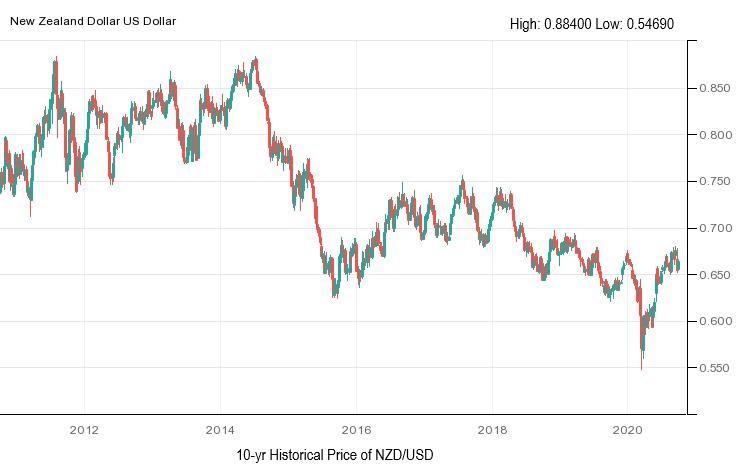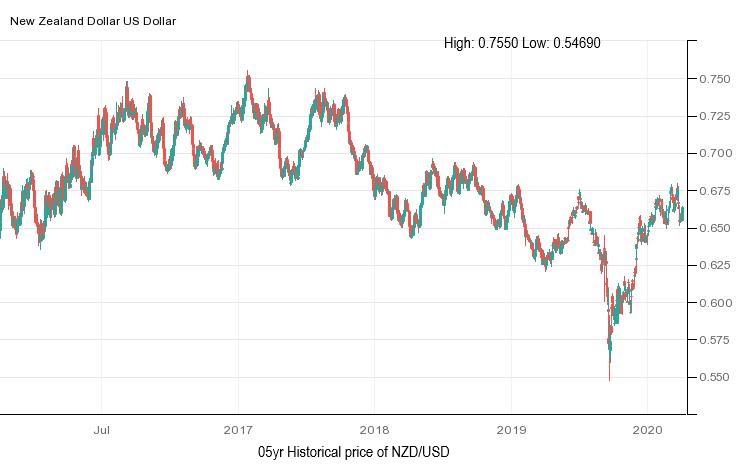The New Zealand Dollar to US dollar exchange rate represents the exchange rate of this commodity pair. In commodity pairing, it is also known as the “kiwi” – it was named after the well-known flightless bird that is endemic to New Zealand. The currency pair is related to agricultural commodities, especially dairy products. The relationship between agricultural or dairy products and the New Zealand dollar makes it a commodity-linked currency.
New Zealand is the top dairy exporting country in the world. Any data related to New Zealand’s dairy industry, like the New Zealand Dairy Auction, dramatically affects the local currency and, ultimately, the kiwi i.e. the NZD/USD currency pair. The economy of New Zealand is highly dependent on exports, because of the small size of the country. Australia is New Zealand’s largest trading partner, as it is the closest neighboring country. China is the second-largest trading partner of New Zealand, due to its high demand for milk products.
The currency of New Zealand has taken many forms throughout history, including physical goods, coins, the British Pound and the Australian Pound, all of which functioned as legal tender in the country before the NZD was introduced. New Zealand got its independence via the New Zealand Constitution Act of 1852, and the British Pound and the Australian Pound were used as currency until 1897. However, in 1967, the country created its own currency, named the New Zealand dollar. The NZD is not the currency of New Zealand alone, but also of the Pitcairn Islands, Tokelau, Niue, the Ross Dependency and the Cook Islands. The New Zealand Dollar is one of the top-10 trading currencies of the world.
Current NZD/USD Price: $



Historical Data Tables:
NZD/USD Historical Price Data
| Date | Price | Open | High | Low | Change % |
|---|
Monthly Change
| Date | Price | Open | High | Low | Change % |
|---|
Factors affecting the prices of the NZD/USD pair:
The Reserve Bank of New Zealand:
The central bank of New Zealand is known as the Reserve Bank of New Zealand (RBNZ). The Governor of the RBNZ is in charge of the bank and operates the monetary policy. The policy decisions made by RBNZ regarding the Official Cash Rate and Interest Rates play an important role in the Kiwi’s movement and, ultimately, in the performance of the NZD/USD currency pair.
The Trade Balance:
As we already know, the economy of New Zealand is highly dependent on international trading, and the reports issued relating to the trade balance from New Zealand have a major effect on the price movements of the NZD.
New Zealand is located a considerable distance from the world’s major economies, so it faces a lot of international trade challenges. The main exports of the country include dairy products, wool, vegetables, fish and meat.
Gross Domestic Product & Consumer Price Index:
The monthly GDP and CPI data released in both countries, i.e. the United States and New Zealand, plays a major role in deciding the movement of the NZD/USD prices. The GDP is a gauge of the economy’s overall economic performance, and the CPI measures the changes in price levels that influence the demand for local currencies.
Political Events:
The countries involved in the NZD/USD pair are New Zealand and the United States. Both countries have a close trading partnership with Australia and China. Any political uncertainty in the biggest trading countries can affect the NZD/USD currency pair.
Employment Figures:
Employment Change reports from both nations also affect the movements of the currency pair. From New Zealand, the Household Labor Force Survey releases data about employment/unemployment rates, newly employed people and the number of hours worked in different industries.
Commodity Prices:
The overall economic performance of New Zealand is largely dependent on its export of agricultural commodities, such as dairy products, meat, fish and vegetables. If the prices of commodities rise, then the income from the country’s exports increases at the same time. A large portion of New Zealand’s GDP comes from the country’s exports. The increased amount of New Zealand commodity exports means a higher GDP, which in turn reflects a strong economic performance and leads to an appreciation of the NZD and vice versa.
In short, it means that higher commodity prices in New Zealand have a strong positive relationship with the NZD/USD currency pair.
Trading Partners:
Since Australia is the largest trading partner of New Zealand, Australia’s economic performance also has a huge impact on the prices of the NZD. New Zealand’s second-largest trading partner is China, with major exports of dairy products to the Dragon Nation. China’s economic conditions also play an important part in affecting the prices of the New Zealand Dollar, and therefore also on the NZD/USD prices.
Carry Trades:
As New Zealand enjoys higher interest rates, just like Australia compared to other major economies, such as the United States, the United Kingdom and Japan, the local currency gets to benefit from carry trades. The interest rate differentials between economies affect the flow of money into the country.
Investors tend to move towards higher interest rates and sell lower-yielding investments, in order to earn more. This method is known as carry trading. So, the New Zealand exchange rate often generates more money flow, due to higher interest rates and carry trades.



